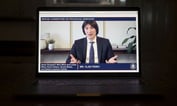So, it’s little wonder they’re discounting central bankers’ talk of higher borrowing costs in 2015 as oil plunges, roiling markets worldwide and lowering the growth outlook.
“The Fed believes it understands market turmoil,” Jim Vogel, a fixed-income strategist at FTN Financial, wrote yesterday in a research note. “Central banks have a lot more to learn when it comes to global financial conditions.”
Fed policy makers concluded a two-day meeting in Washington on Wednesday after discussing their plan to withdraw monetary stimulus and hashing out what the collapse in oil means for the outlook. Central bankers said they’d be “patient” on the timing of the first borrowing-cost increase since 2006 and lowered their forecast for interest rates at the end of next year.
Here are five ways traders have been telling the Fed that they should postpone their tightening strategy:
1. Inflation expectations have fallen close to where they were right before the Fed embarked on its second round of bond purchases, or quantitative easing, in 2010. QE2 was controversial because it fueled concern that inflation would spike (that never happened), but expectations that prices would accelerate faster were exactly what central bankers wanted. Traders are pricing in consumer price increases over the next five years of about 1 percent — well below the Fed’s 2 percent goal for price stability.









 December 17, 2014 at 02:49 PM
December 17, 2014 at 02:49 PM














